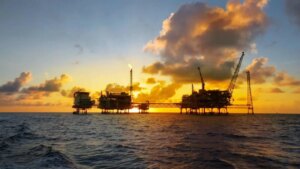Great news today as Prime Minister Anthony Albanese announces the Future Made in Australia Act, designed to deliver a uniquely Australian Response to the US Inflation Reduction Act (IRA) which is turbocharging renewables, cleantech and reindustrialisation in the US as it mobilises massive private capital investment.
The PM indicates the Federal Government will work on public-private collaboration, which will leverage the firepower of our federal public balance sheet and budget to de-risk investments and crowd-in private climate capital, including our world leading $3.6 trillion superannuation pool plus the collective $4 trillion in big bank balance sheets.
Australia’s Big 4 banks are chief actors in allocating private debt capital at scale to achieve our sustainable economy growth goals. To date, the Big 4 have established $385bn (and growing) worth of sustainable finance targets (SFT) that are, in part, aimed at contributing to climate change mitigation.
However, Climate Energy Finance’s new research finds that only 7% of the big 4 banks’ SFTs finance renewable energy and industry decarbonisation.
The vast majority – between 44% and 72% – is channelled into the low hanging fruit of BAU ‘green buildings’ that meet minimum energy efficiency regulations under the National Construction Code, without necessarily driving retrofit financing at scale.
While energy efficient buildings are key to reducing grid demand during peak summer and winter months, buildings are only truly green once they are fully electrified, the grid is producing zero emissions electricity, and building materials are decarbonised.
That requires concerted action and capital allocation to build firmed utility-scale renewable energy, and reduce emissions in hard-to-abate sectors like steel, cement, and aluminium.
The lack of sufficient capital allocation into cleantech and renewables puts Australia behind in the race to capture the massive investment, trade and employment opportunities of the net zero transformation. It also leaves the banks open to accusations of greenwash.
CBA’s current allocation under its $70bn SFT by 2030 boasts the worst renewable energy to green building financing ratio, investing nearly $8 into minimum regulatory-grade buildings for every dollar it invests in renewables.
NAB’s major focus looks to have been a green property play comprising almost 50% of its $70bn SFT allocation to FY2022 with little transparency in decarbonisation of other sectors. NAB needs to provide more transparency over where its new FY2024 SFT is contributing to real climate change mitigation.
Westpac’s $15bn total committed exposure (TCE) target is by far heading in the right direction, with a higher proportion of financing enabling renewable energy and low carbon transport than the other banks, but needs scaling up fivefold.
ANZ has a cumulative $150bn this decade, the largest sum by far, but its contribution to real world outcomes is largely opaque with a combined 64% allocation towards sustainability-linked and facilitative finance.
It means this capital could be allocated in a way that is misaligned to the transition – certainly a risk given ANZ’s ongoing high fossil fuel exposure, high degree of fossil fuel-influenced Board directors, and being the only remaining Big 4 to lack a substantive policy that restrict financing of new oil and gas.
To date, each bank has been ahead of track to hit their target and has acted quickly to establish new, more ambitious SFTs – a testament to the bank’s capital being ready to be deployed at scale to support decarbonisation and sustainability goals.
CBA has allocated a massive $45bn over three years towards its $70bn sustainable finance target. NAB last year hit its $70bn environmental financing pledge and promises to establish a new more ambitious target this year.
Westpac is increasing its climate solutions ambition from $15bn to $55bn total exposure by 2030, plus $40bn in bond facilitation. ANZ began with a $50bn SFT in 2020 and last year extended “at least” an additional $100bn in support of ‘environmental and social outcomes’ this decade.
The first draft of a national sustainable finance taxonomy, under development by the Australian Sustainable Finance Institute, is due for release next month and will provide more consistent definitions across asset classes captured within the banks’ SFTs.
But, alone, the taxonomy is unlikely to turn this bleak picture around, especially within the next two years which the UN Climate Chief yesterday announced is the crucial time period in which to save the planet.
The new Future Made in Australia Act will establish strong market signals towards building future-facing sectors, including clean energy generation at utility-scale, zero emissions transport and decarbonised heavy industry.
It will be up to the banks to align their capital allocation and reporting to the new taxonomy from FY2025 and, crucially, to prioritise financing that achieves the objectives of the new Act.
This is what Australia needs to see, instead of the current over-emphasis on refinancing green buildings masquerading as a comprehensive response to climate and decarbonisation imperatives.






